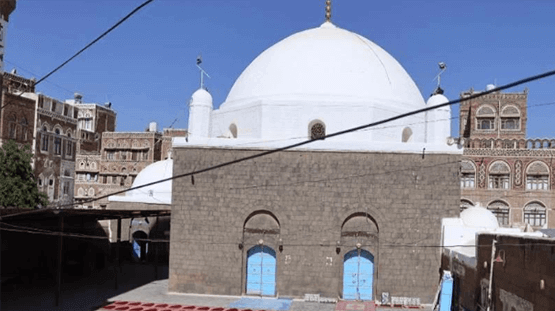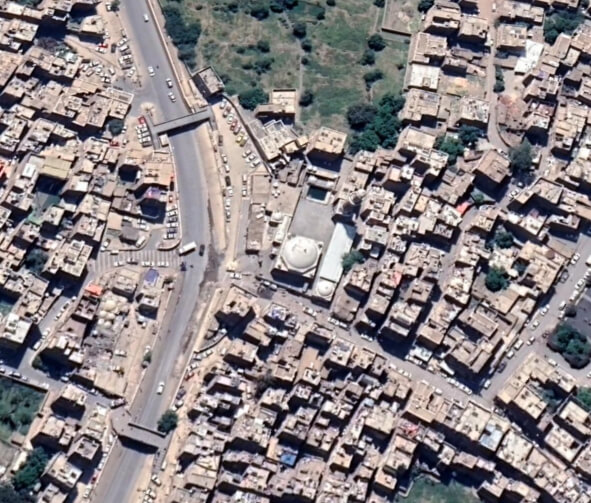
Marna’ Al-Mahdī ‘Abbās (Well ramp) – Old Ṣan‘ā’
مرنع المھدي عباس- صنعاء القدیمة
Monument description
Al-Mahdi Abbas Well Ramp is one of the most famous historical monuments in the old city of Sana’a. It is located to the southeast of the Dome of Al-Mahdi Mosque and is bordered on the east by the district of Sana’a, on the north by the Dome of the Mahdi Mosque and the Al-Nahrain neighborhood, and from the west and south, Bustan Al-Jami’ and Bustan Al-Sultan neighborhood. Using the traditional method of extracting water, the well and its ramp function were to supply the Matahir (Ablution Unit) of the nearby Mosque, to water the neighboring bustan (garden) in Bustan Al-Sultan neighborhood and other neighborhoods. Currently it is used as a traditional cafe whose proceeds are used to support the Mosque.

Architectural and cultural value
Construction style and built date: The monument is considered a distinct model of one of the architectural styles prevalent in old Sana’a, which builds the well hole from the inside with stones called Tawia, and raises two walls on both sides of the well, which are called Sawari (of the well), and the timber on which ropes are attached between them. At the bottom, a guttered basin is built that receives water. The building of the ramp is made of stones, with a vaulted ceiling made of bricks (Yajour); the well ramp has been roofed and the floor is inclined to be kind to animals.The construction of the Mosque dates back to 1164 AH / 1751 CE by Imam Al-Mahdi Lideen Allah Abbas bin Al-Mansour Hussein bin Al-Mutawakkil Al-Qasim bin Al-Hussain bin Ahmed bin Al-Hasan bin Al-Imam Al-Qasim bin Muhammad, during his rule in Yemen, and during the construction of the nearby Mosque, which It bears his name. The neighboring Bustan Al-Sultan area was an active area, as the seat of government was transferred to it during his father rule Imam Al-Mansur. Wells and marinas are among the distinctive architectural elements of ancient Sana’a. For two and a half centuries, this monument has been supplying the residents of the area and the visitors of the nearby Mosque with water. It is considered an integrated model of the traditional method of extracting water from the ground using animals, a method that remained prevalent in Yemen until the late twenty century.
Components of the Mosque: The Monument consists of a well, two side rails, a water-gathering basin (Margo), a well ramp roofed with a vaulted ceiling, and a sloping floor. The area of the well ramp is 242,87 m2.
- Justifications for intervention:
- 1 – An Islamic monument.1 – An Islamic monument
- 2 – Protecting the monument from flooding by building wall fenders.
- 3 – Re-implementation the ceiling Qudad Layer that is damaged.
- 4 – Replace the dilapidated lintel and treat the wooden elements.
- Monument conditions and treatment:
- The monument’s general condition are moderately damaged, as it underwent restoration work about twenty years ago by the Heritage Unit of the SFD, but now it suffers from serious damages that makes it vulnerable to to perish, and the damages are as follows:
Serious damages:
1. Large cracks up to 4 cm wide, forming a separation between the ceilings and walls, appear in the ceiling above the eastern facade of the building, with a length of 40 m.
2. The foundations of the eastern wall of the well ramp were severely damaged due to the constant moisture and water leakage from the wall courses to the lower walls, which led to the appearance of dents and bulges in it and the erosion of stones.
3. The leakage of torrential water into the park through the walls of the foundations on the southern side.
4. The door wooden lintels the were damaged, their components were corroded, and some parts were lost.
5. A dent in one of the ceiling arches, and the use of pre-shaped stones to repair the arches, which is considered as a distortion of the historical monument.
6. Damages to the walls of the posts around the well in the areas of wood installation on both sides.
7. Damage to the wood of the well between the two poles.
8. Accumulation of waste inside the floor of the park as a result of rainwater leaking into the well ramp.

Countries











